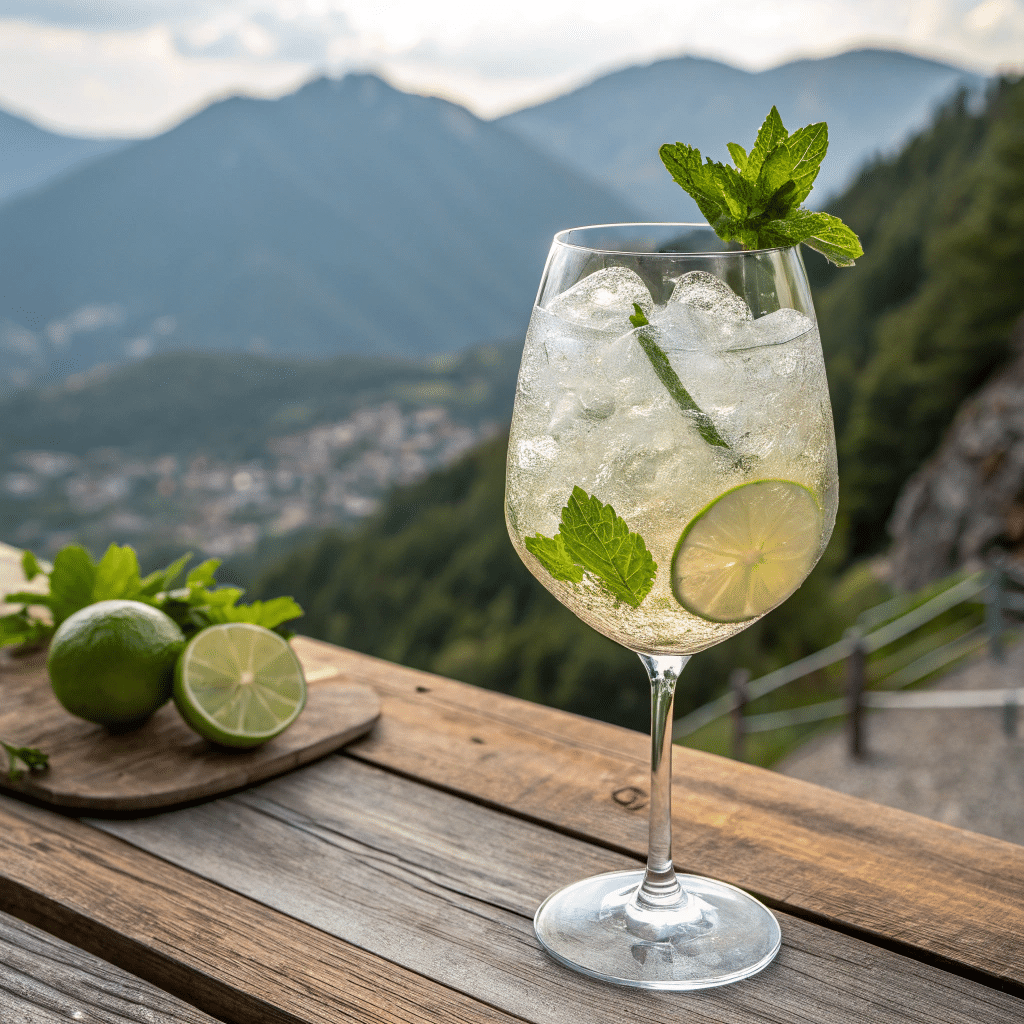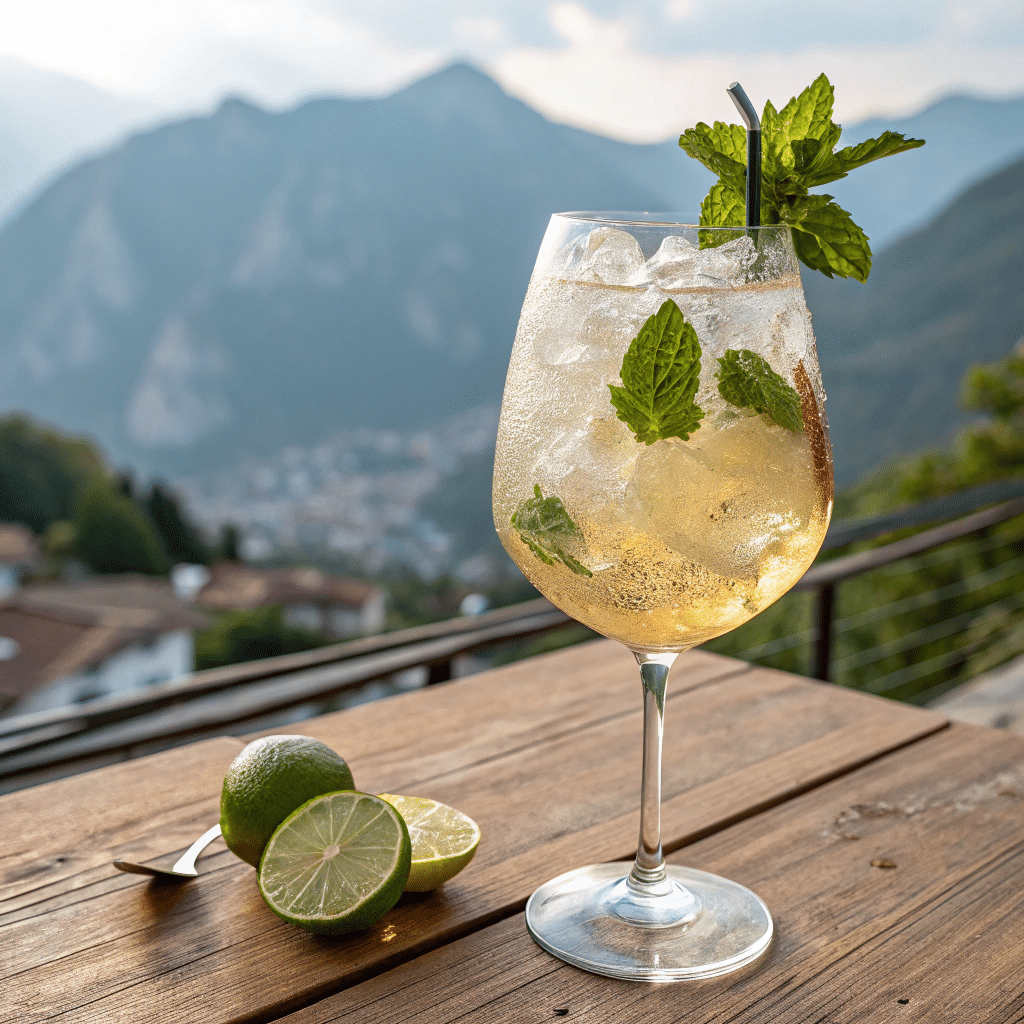Table of Contents
Table of Contents
Hugo Spritz: The Delicious 5-Minute Italian Cocktail That Changed My Summer
Last year, I was sitting on my front porch in Madison, Georgia, watching the sun set after a particularly hot day. My neighbor Sarah had just returned from a trip to Northern Italy and was bubbling with excitement about this Hugo spritz she’d discovered in a tiny café nestled in the mountains. She described it as the most refreshing drink she’d ever tasted, something floral and fizzy that transported her straight to the Italian Alps. Naturally, being someone who can’t resist a good drink story, I asked her to recreate it right there on my porch. What happened next was nothing short of magical.
As Sarah mixed elderflower liqueur with bubbling prosecco and topped it with fresh mint from my garden, I knew I was about to taste something special. That first sip of Hugo spritz was like summer sunshine in a glass, light and refreshing with the most beautiful floral notes I’d ever experienced. The drink was so different from anything I’d tried before, completely unlike the bitter edge of an Aperol spritz, yet equally satisfying. Right then and there, with the Georgia humidity hanging heavy in the air, I fell completely in love with this Hugo spritz recipe. It became our go-to drink for every porch gathering, and honestly, it hasn’t left my regular rotation since.
This Italian aperitif cocktail originated in South Tyrol, a northern Italian province in the Dolomite mountains, where bartender Roland Gruber created it in 2005. The Hugo spritz combines prosecco, elderflower liqueur, sparkling water, fresh mint, and citrus in perfect harmony. What makes this drink so special is its delicate balance of floral sweetness from elderflower, herbal freshness from mint, and the bright effervescence of quality prosecco. Unlike traditional spritzes that rely on bitter liqueurs, the Hugo spritz offers a lighter, more approachable flavor profile that’s perfect for anyone seeking a refreshing summer cocktail.
Print
Amazing Hugo Spritz: 5 Secrets for Perfect Italian Cocktails
- Total Time: PT0H5M
- Yield: 1 serving
- Diet: Vegetarian
Description
A refreshing Italian aperitif cocktail from South Tyrol featuring elderflower liqueur, prosecco, fresh mint, and lime. This Hugo Spritz is lighter and more floral than Aperol Spritz.
Ingredients
3 oz prosecco
1.5 oz St-Germain elderflower liqueur
1 oz sparkling water
8–10 fresh mint leaves
1 lime wheel
1 mint sprig for garnish
Ice cubes

Instructions
Step 1: Fill a large wine glass with ice cubes
Step 2: Add elderflower liqueur to the glass
Step 3: Gently muddle 8-10 mint leaves in the liqueur
Step 4: Pour prosecco slowly to preserve bubbles
Step 5: Top with sparkling water
Step 6: Stir gently to combine
Step 7: Garnish with lime wheel and mint sprig
Step 8: Serve immediately

Notes
Use dry prosecco for best balance
Don’t overmuddle mint to avoid bitterness
Chill all ingredients beforehand
Adjust elderflower liqueur to taste preference
- Prep Time: PT0H5M
- Cook Time: PT0H0M
- Category: Cocktail
- Method: Mixed
- Cuisine: Italian
The Perfect Hugo Spritz Recipe: Italian Elegance Made Simple
Creating the ideal Hugo spritz doesn’t require bartending expertise or fancy equipment. This Northern Italian cocktail follows a simple formula that celebrates each ingredient’s unique contribution to the final drink. The beauty of a Hugo spritz lies in its simplicity and the quality of its components.
Essential Ingredients That Make the Difference
The foundation of any excellent Hugo spritz starts with selecting the right ingredients. Quality prosecco forms the bubbly base, while elderflower liqueur (typically St-Germain) provides the signature floral sweetness that distinguishes this cocktail from its cousins. Fresh mint leaves add aromatic depth, and sparkling water contributes extra effervescence that makes each sip feel light and refreshing.
Many recipes suggest using elderflower syrup instead of liqueur for a lower-alcohol version, but I’ve found that St-Germain elderflower liqueur creates a more balanced flavor profile. The lime or lemon garnish isn’t just decorative either. It adds a bright citrus note that complements the elderflower beautifully and helps balance the drink’s natural sweetness. When I’m making Hugo spritz for guests, I always have them taste the fresh lime juice before adding it to appreciate how it transforms the entire drinking experience.
Traditional Italian Ratios and Mixing Techniques
The classic Hugo spritz follows the traditional 3-2-1 spritz ratio, but with elderflower liqueur replacing the bitter components found in other variations. Most bartenders recommend 3 parts prosecco, 1.5 parts elderflower liqueur, and 1 part sparkling water, though these proportions can be adjusted based on personal preference.
Building the drink properly makes a significant difference in the final result. I always start with ice-filled wine glasses, add the elderflower liqueur first, then gently muddle fresh mint leaves to release their oils without bruising them. The prosecco goes in next, followed by a splash of sparkling water and a gentle stir to combine everything. During my summer parties, guests often ask for seconds of this white cranberry juice alternative, and I’ve learned that the garnish truly matters – a sprig of fresh mint and a lime wheel make the drink feel special and complete.

Mastering the Art of Hugo Spritz: Pro Tips and Variations
Understanding what makes a Hugo spritz exceptional goes beyond simply following a recipe. The nuances of preparation, ingredient selection, and presentation can transform a good drink into an unforgettable experience that captures the essence of Italian aperitivo culture.
Temperature and Glassware Secrets
Proper temperature control separates amateur Hugo spritz makers from those who truly understand the craft. Every component should be well-chilled before mixing – prosecco, elderflower liqueur, and sparkling water all benefit from refrigeration. I’ve discovered that placing ingredients in a bowl of salted ice water for 10 minutes works wonders when you’re short on time.
The choice of glassware significantly impacts the drinking experience. Large wine glasses or balloon glasses work best because they provide ample space for ice and allow the mint’s aroma to develop properly. Never skimp on ice either – fill the glass completely to the top with cubes to keep the cocktail colder longer and prevent dilution. During my Shirley Temple experiments, I learned that proper ice technique applies to all fizzy drinks, and the Hugo spritz is no exception.
Creative Twists on the Classic Formula
While the traditional Hugo spritz is perfect as written, subtle variations can create interesting new experiences without losing the drink’s essential character. Some bartenders add cucumber slices for extra freshness, while others incorporate different citrus elements like lemon instead of lime. Berry additions work beautifully during summer months, particularly when you want to complement the elderflower’s natural fruit notes.
Experimenting with different elderflower products can also yield interesting results. Elderflower cordial creates a slightly different flavor profile than liqueur, though it requires careful balancing to maintain the drink’s integrity. When I’m serving Hugo spritz alongside my delicious pistachio cream desserts, I sometimes add a tiny splash of rose water for an extra floral dimension that pairs beautifully with the Italian theme.
Hugo Spritz vs Aperol Spritz: Understanding the Differences
The comparison between Hugo spritz and Aperol spritz reveals fascinating insights into how small ingredient changes can create completely different drinking experiences. Both cocktails share Italian heritage and similar construction methods, yet they appeal to distinctly different palates and occasions.
Flavor Profile Analysis
The most obvious difference between these two popular spritzes lies in their flavor foundations. Aperol spritz delivers a bitter-sweet citrus experience with prominent orange and rhubarb notes, while Hugo spritz offers a floral, lighter alternative that emphasizes elderflower’s delicate sweetness. The bitter edge that defines Aperol spritz comes from its signature orange aperitif, creating a more complex and assertive flavor profile.
Hugo spritz takes a completely different approach, substituting elderflower liqueur for bitter components and adding fresh mint for herbal complexity. This creates a drink that’s more approachable for those who find traditional aperitifs too intense. The color difference is immediately apparent too – Aperol spritz displays a vibrant orange hue, while Hugo spritz appears pale greenish or almost clear. When I’m planning menus that include both drinks, I often serve them alongside my carajillo recipes to showcase how different cultures approach coffee and cocktail traditions.
Cultural Origins and Regional Preferences
Both cocktails represent distinct regional Italian drinking traditions that reflect their local ingredients and cultural preferences. Aperol spritz emerged from Venice and the Veneto region, where bitter aperitifs traditionally stimulate appetite before meals. Hugo spritz, conversely, originated in South Tyrol near the Austrian border, where elderflower grows abundantly and local preferences lean toward lighter, more floral flavors.
This geographical distinction helps explain why Hugo spritz feels more Alpine and fresh compared to Aperol spritz’s Mediterranean boldness. The South Tyrol region’s unique cultural blend of Italian and Austrian influences shaped the Hugo spritz into something that bridges both traditions beautifully. During my research for this article, I discovered that Roland Gruber originally called his creation “Otto” before settling on “Hugo,” showing how even the name reflects the drink’s evolution within its specific cultural context. The connection between place and flavor reminds me of how my gelato magic research revealed similar regional variations in Italian frozen desserts.

Serving and Pairing Your Hugo Spritz Like an Italian
Authentic Italian aperitivo culture extends far beyond simply mixing drinks – it encompasses timing, presentation, and food pairings that create complete sensory experiences. Understanding these traditions helps transform a simple Hugo spritz into a genuine taste of Northern Italian hospitality.
The Art of Italian Aperitivo Hour
True aperitivo culture revolves around specific timing and social rituals that make Hugo spritz more than just another cocktail. Italians typically enjoy aperitivo between 6 and 8 PM, creating a gentle transition from day to evening that stimulates appetite while encouraging conversation. The Hugo spritz fits perfectly into this tradition because its lower alcohol content and refreshing nature allow for extended sipping without overwhelming the palate.
Presentation matters enormously in Italian drinking culture. Always serve Hugo spritz in proper glassware with fresh garnishes, and never rush the preparation process. The ritual of building the drink becomes part of the experience, whether you’re entertaining guests or treating yourself after a long day. I’ve found that preparing Hugo spritz alongside appetizers creates the perfect atmosphere for relaxed socializing, much like when I’m serving my ice cream cake at summer gatherings.
Perfect Food Pairings and Seasonal Considerations
Hugo spritz pairs beautifully with light, fresh foods that complement its floral character without competing for attention. Classic Italian antipasti work wonderfully – think fresh mozzarella, prosciutto, olives, and seasonal vegetables. The drink’s elderflower notes particularly complement seafood, making it an excellent choice for summer seafood platters or light pasta dishes.
Seasonal fruit pairings enhance the Hugo spritz experience throughout the year. Summer berries echo the elderflower’s natural fruit undertones, while autumn pears create interesting flavor bridges. During cooler months, I sometimes adjust the recipe slightly by adding warming herbs like rosemary, though purists might argue this strays too far from tradition. The versatility reminds me of how I adapt my strawberry shortcake ice cream recipes for different seasons while maintaining their essential character.
Frequently Asked Questions
What is the difference between Aperol and Hugo Spritz?
The main difference lies in their base liqueurs and resulting flavor profiles. Aperol spritz uses bitter orange aperitif creating a bitter-sweet, citrusy taste with vibrant orange color, while Hugo spritz uses elderflower liqueur producing a floral, lighter flavor with pale greenish appearance. Hugo spritz also includes fresh mint, making it more herbal and aromatic than its bitter cousin.
What is the ratio for Hugo?
The traditional Hugo spritz follows a 3-2-1 ratio: 3 parts prosecco, 2 parts elderflower liqueur, and 1 part sparkling water. However, many bartenders prefer a modified ratio of 3 parts prosecco, 1.5 parts elderflower liqueur, and 1 part sparkling water for better balance. The exact proportions can be adjusted based on personal preference for sweetness and alcohol content.
What is the difference between a spritz and a Hugo?
A spritz is a category of Italian cocktails that typically combine sparkling wine, a liqueur or aperitif, and sparkling water. Hugo is a specific type of spritz that uses elderflower liqueur instead of bitter aperitifs like Aperol or Campari. While all Hugos are spritzes, not all spritzes are Hugos – the defining characteristic is the elderflower base and fresh mint garnish.
What does Hugo Spritz taste like?
Hugo spritz offers a light, refreshing taste with prominent floral notes from elderflower liqueur balanced by herbal freshness from mint. The flavor profile includes delicate sweetness, citrus brightness from lime, and effervescent bubbles from prosecco and sparkling water. Unlike bitter aperitifs, it provides a smooth, approachable drinking experience with subtle fruit undertones and a clean, refreshing finish.
conclusion
The Hugo spritz represents everything I love about discovering new flavors through travel and shared experiences. From that first magical evening on my Georgia porch to countless summer gatherings since, this Northern Italian cocktail has become more than just a drink in my repertoire. It’s a reminder that sometimes the most beautiful discoveries come from simple ingredients combined with perfect technique and shared with people you care about. Whether you’re hosting friends, enjoying a quiet moment alone, or dreaming of Alpine cafés, the Hugo spritz delivers that perfect taste of Italian sophistication in every refreshing sip.
For more recipes, visit my Facebook page.
